What’s the biggest bird that can fly? This is a question that fascinates aviation enthusiasts and bird lovers alike. At flyermedia.net, we’re committed to providing you with the most comprehensive and up-to-date information about all things aviation, including the magnificent creatures that share our skies. Let’s embark on a journey to discover the largest flying birds, their unique characteristics, and where you can spot them. Discover interesting facts about the amazing avians and learn where to find them.
1. Understanding Bird Size: Wingspan, Weight, and Other Metrics
How do we measure the size of a bird? When determining the largest flying bird, different metrics come into play. While weight might seem like an obvious choice, it’s not always the most accurate when considering flight. Wingspan, the distance from one wingtip to the other, is a crucial factor for birds that soar through the skies. Other factors like height and body length also contribute to our understanding of a bird’s overall size and how it adapts to its environment.
2. The Top 10 Largest Flying Birds By Wingspan
What are the top 10 largest flying birds in the world? Here is a list of the top 10 largest flying birds in the world, focusing on wingspan, but also considering weight and other interesting features, to provide a comprehensive overview.
| Rank | Bird | Wingspan (meters) | Weight (kg) | Interesting Facts |
|---|---|---|---|---|
| 1 | Wandering Albatross | 3.2 | 12 | Longest wingspan of any living bird; can travel over 120,000 km in a year. |
| 2 | Cinereous Vulture | 3.0 | 13 | Largest Old World vulture; plays a crucial role in ecosystems by scavenging carcasses. |
| 3 | Andean Condor | 3.0 | 16 | Largest flying bird in the Western Hemisphere; can fly for hours without flapping its wings. |
| 4 | Marabou Stork | 2.9 | 9 | Tall and capable flier; scavenges through trash piles in East Africa. |
| 5 | Kori Bustard | 2.47 | 18 | One of the heaviest flying birds; spends a lot of time on the ground. |
| 6 | Trumpeter Swan | 2.4 | 15 | Largest waterfowl in North America; known for its loud call. |
| 7 | Steller’s Sea Eagle | 2.3+ | 10 | One of the largest eagles in the world; native to coastal northeastern Asia. |
| 8 | Secretarybird | 2.1 | 4.27 | Tall bird of prey that spends most of its time on the ground hunting snakes and other small animals. |
| 9 | Dalmatian Pelican | 1.9 | 15 | Largest pelican species; has a huge wingspan and a large throat pouch for catching fish. |
| 10 | Blakiston’s Fish Owl | 1.8 | 4.6 | One of the largest owl species; lives in East Asia and Russia. |
3. The Wandering Albatross: King of the Skies
What makes the Wandering Albatross the biggest bird that can fly? The Wandering Albatross (Diomedea exulans) holds the record for the largest wingspan of any living bird, typically measuring around 3.2 meters (10.5 feet), with verified reports reaching an astonishing 3.63 meters (11 feet 11 inches). These majestic birds are true masters of the air, capable of traveling vast distances across the open ocean. According to research published in Nature, Wandering Albatrosses can cover over 120,000 km (75,000 miles) in a single year, spending almost their entire lives in the air, only landing to eat and breed. Their ability to soar effortlessly for extended periods is due to their exceptional wingspan and specialized flight techniques, making them the undisputed champion of the skies.
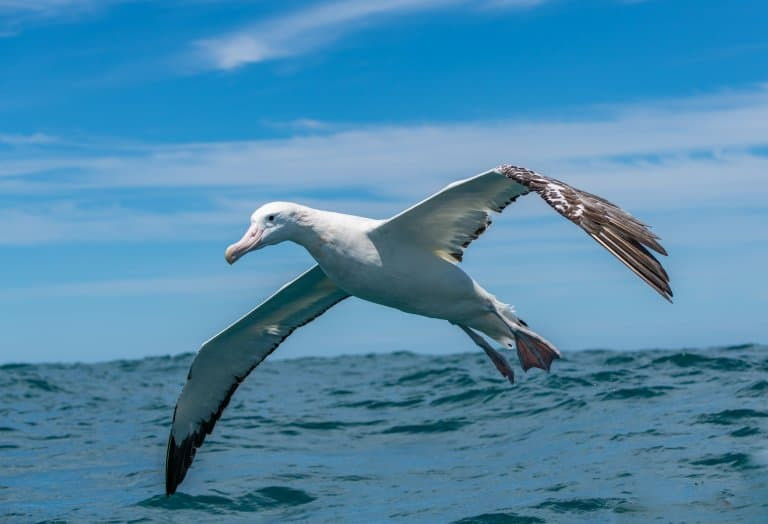 Wandering Albatross
Wandering Albatross
The Wandering Albatross exhibits the largest wingspan of any living bird.
4. Other Contenders for the Title
Are there any other birds with impressive wingspans? While the Wandering Albatross takes the top spot, other birds boast impressive wingspans that rival its own.
4.1. Andean Condor
What is special about the Andean Condor? The Andean Condor (Vultur gryphus) is the largest flying bird in the Western Hemisphere and one of the largest in the world, with a wingspan that can reach up to 3 meters (9.8 feet). These magnificent birds are found in the Andes Mountains of South America, where they play a vital role in the ecosystem as scavengers. Their immense wing area allows them to soar effortlessly at high altitudes, covering vast distances in search of food.
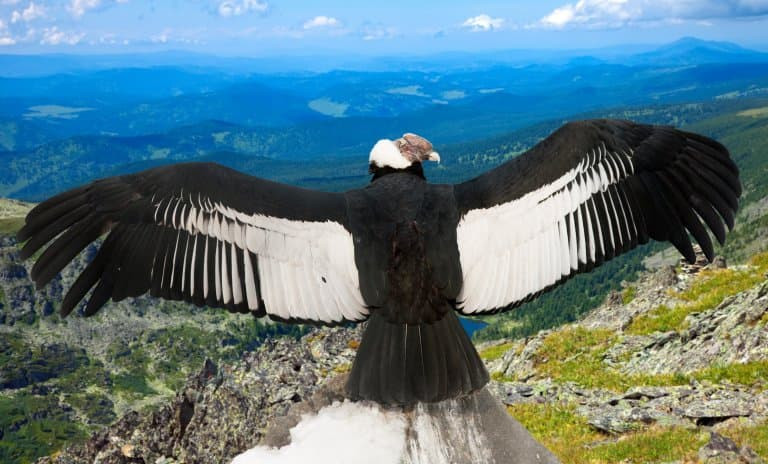 Andean Condor
Andean Condor
The Andean Condor is among the largest flying bird with a wingspan of up to 3 meters.
4.2. Cinereous Vulture
What is the role of the Cinereous Vulture in the ecosystem? The Cinereous Vulture (Aegypius monachus), also known as the Black Vulture, is the largest Old World vulture and one of the largest flying birds, with a wingspan that can also reach up to 3 meters (9.8 feet). These impressive birds are found across Europe and Asia, where they play a crucial role in ecosystems by scavenging carcasses and preventing the spread of disease. They are known for their powerful flight and ability to soar for long periods, covering vast distances in search of food.
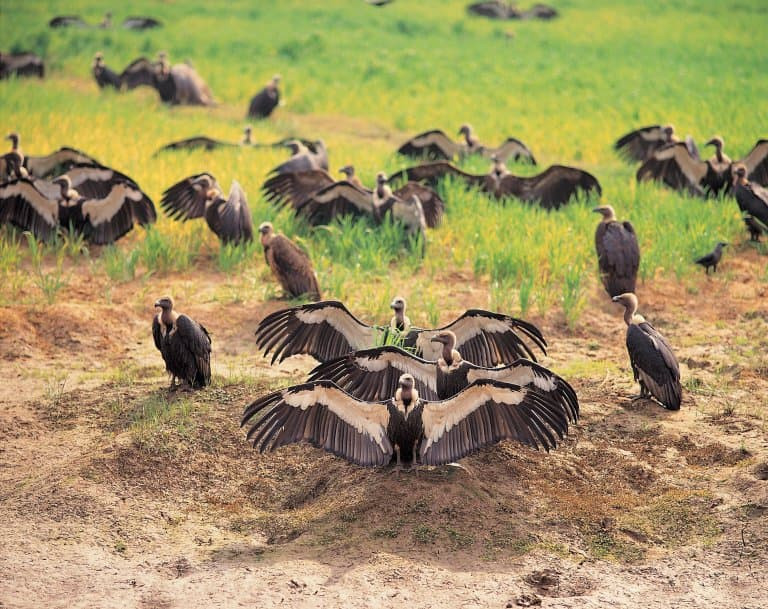 cinereous vulture
cinereous vulture
The Cinereous Vulture has a large wingspan and contributes greatly to maintaining a healthy ecosystem.
4.3. Marabou Stork
Where does the Marabou Stork live? The Marabou Stork (Leptoptilos crumeniferus) is a large African stork with a wingspan that can reach up to 2.9 meters (9.5 feet). These imposing birds are often found near human settlements, where they scavenge for food in trash piles and landfills. While they may not be the most attractive birds, they are highly efficient fliers, capable of soaring for long distances in search of food.
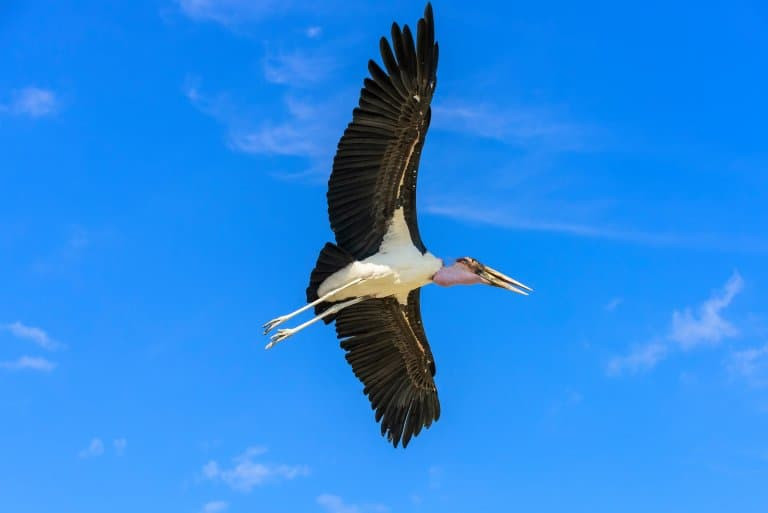 Marabou Stork wingspan
Marabou Stork wingspan
The Marabou Stork scavenges through trash piles and has a wingspan of up to 2.9 meters.
5. Heavyweights of the Sky
Which birds are considered the heavyweights of the sky? While wingspan is a key factor in determining the largest flying bird, weight also plays a significant role. Some birds, like the Kori Bustard and Trumpeter Swan, are among the heaviest flying birds, despite not having the largest wingspans.
5.1. Kori Bustard
How heavy is the Kori Bustard? The Kori Bustard (Ardeotis kori) is a large African bird that is considered one of the heaviest flying birds, with males weighing up to 18 kg (39 lbs). While their wingspan is relatively modest at around 2.47 meters (8.1 feet), their sheer bulk makes them a force to be reckoned with. These birds spend a significant amount of time on the ground, foraging for food and defending their territory.
5.2. Trumpeter Swan
Where can you find Trumpeter Swans? The Trumpeter Swan (Cygnus buccinator) is the largest waterfowl species in North America and one of the heaviest flying birds, with males weighing up to 15 kg (33 lbs). These majestic birds have a wingspan of around 2.4 meters (7.9 feet) and are known for their loud, trumpet-like calls. They are found in wetlands and lakes across North America, where they feed on aquatic plants and insects.
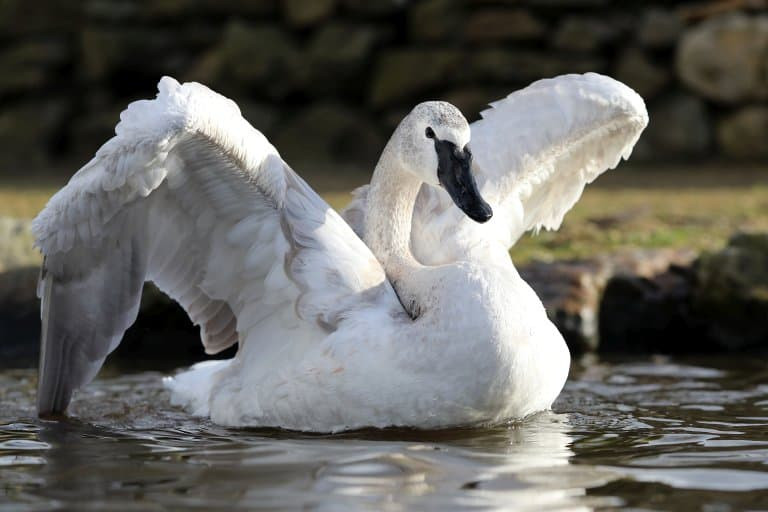 Trumpeter Swan
Trumpeter Swan
The Trumpeter Swan is the biggest waterfowl in North America.
6. Eagles: The Apex Predators of the Air
Which eagles are considered the largest? Eagles are apex predators known for their impressive size, strength, and aerial prowess. Several eagle species rank among the largest flying birds, including the Steller’s Sea Eagle, Harpy Eagle, and Philippine Eagle.
6.1. Steller’s Sea Eagle
Where does the Steller’s Sea Eagle live? The Steller’s Sea Eagle (Haliaeetus pelagicus) is one of the largest eagles in the world, with a wingspan that can exceed 2.3 meters (7.5 feet). These magnificent birds are found in coastal northeastern Asia, where they prey on fish and waterfowl. They are known for their striking appearance, with a dark brown body, white shoulders, and a large yellow bill.
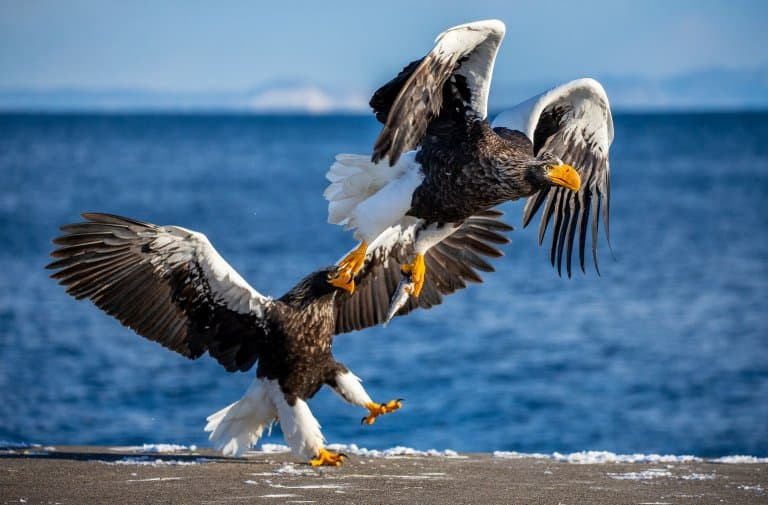 Steller
Steller
The Steller’s Sea Eagle lives in coastal northeastern Asia.
6.2. Harpy Eagle
What does the Harpy Eagle eat? The Harpy Eagle (Harpia harpyja) is a massive eagle found in Central and South America, with females weighing up to 9 kg (20 lbs). While their wingspan is relatively shorter compared to other large eagles, their powerful talons and muscular build make them formidable hunters. They prey on a variety of animals, including monkeys, sloths, and other mammals.
6.3. Philippine Eagle
Why is the Philippine Eagle endangered? The Philippine Eagle (Pithecophaga jefferyi) is a critically endangered eagle found only in the Philippines. It is one of the largest eagles in the world, with a wingspan that can reach up to 2.2 meters (7.2 feet). These majestic birds are threatened by habitat loss and hunting, and their populations continue to decline.
7. Owls: The Silent Giants of the Night
Which owls are considered the largest? Owls are nocturnal predators known for their silent flight, keen eyesight, and powerful talons. Several owl species rank among the largest flying birds, including the Blakiston’s Fish Owl and Eurasian Eagle-Owl.
7.1. Blakiston’s Fish Owl
Where does the Blakiston’s Fish Owl live? The Blakiston’s Fish Owl (Bubo blakistoni) is one of the largest owl species in the world, with a wingspan that can reach up to 1.8 meters (6 feet). These elusive birds are found in East Asia and Russia, where they prey on fish and other aquatic animals. They are adapted to cold, harsh environments and have specialized features that allow them to hunt in icy waters.
 Blakiston’s Eagle Owl
Blakiston’s Eagle Owl
The Blakiston’s Fish Owl is one of the largest owl species in the world.
7.2. Eurasian Eagle-Owl
What does the Eurasian Eagle-Owl eat? The Eurasian Eagle-Owl (Bubo bubo) is another contender for the title of largest owl species, with a wingspan that can also reach up to 1.8 meters (6 feet). These powerful owls are found across Europe and Asia, where they prey on a variety of animals, including rodents, birds, and even small mammals. They are highly adaptable and can thrive in a variety of habitats, from forests to deserts.
8. Pelicans: The Pouch-Bearing Giants
Which pelicans are considered the largest? Pelicans are large waterbirds known for their distinctive throat pouches, which they use to scoop up fish and other aquatic prey. The Dalmatian Pelican is the largest pelican species and one of the largest flying birds.
8.1. Dalmatian Pelican
Where does the Dalmatian Pelican live? The Dalmatian Pelican (Pelecanus crispus) is the largest pelican species, with a wingspan that can reach up to 1.9 meters (6.2 feet). These massive birds are found in southeastern Europe and Asia, where they inhabit lakes, rivers, and coastal waters. They are highly social birds and often gather in large flocks to feed and breed.
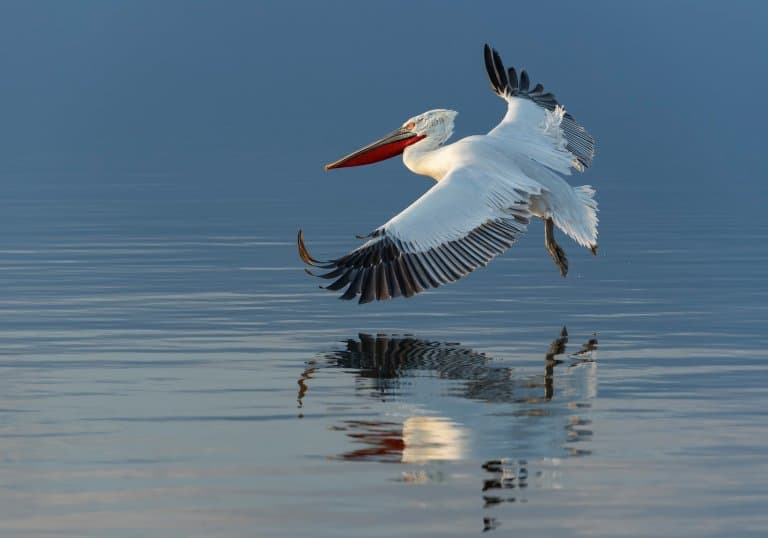 Dalmatian Pelican
Dalmatian Pelican
The Dalmatian Pelican is the largest species of pelican.
9. The Secretarybird: A Unique Hunter
What makes the Secretarybird unique? The Secretarybird (Sagittarius serpentarius) is a unique bird of prey found in Africa. While it is not the heaviest or largest bird, it is one of the tallest, standing up to 1.3 meters (4.3 feet) tall. They are known for their long legs and ability to hunt snakes and other reptiles on foot. Their wingspan can reach up to 2.1 meters (6.9 feet), allowing them to take flight when necessary.
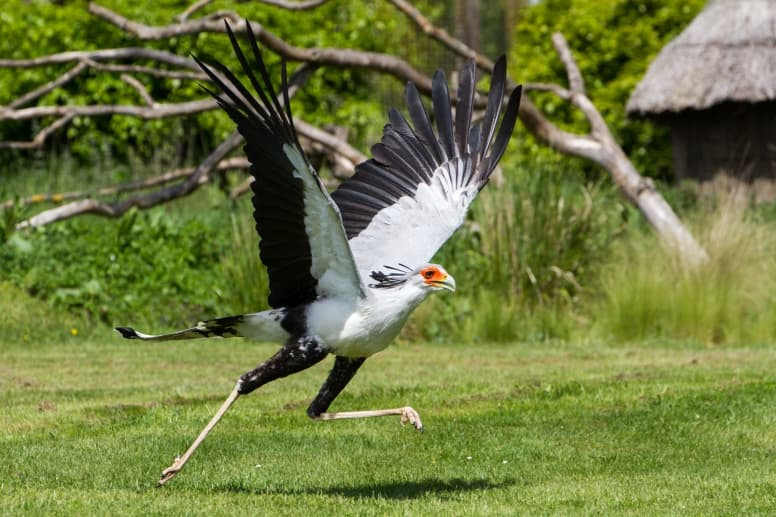 secretarybird facts
secretarybird facts
The Secretarybird is unique because it mostly uses the wind for lift.
10. The Importance of Size in the Bird World
Why is the size of birds important to track? The size of a bird is more than just a matter of bragging rights; it’s an important metric for understanding the bird’s biology, ecology, and conservation status. Size measurements can provide insights into a bird’s gender, diet, energy requirements, and role in the ecosystem. According to research from Stanford University, males are typically larger than females in most bird species, but this pattern is reversed in some families, such as birds of prey, where females are often larger than males. The reasons for this sexual dimorphism are still not fully understood.
11. Flightless Giants: Birds That Gave Up on Flying
Are there any large birds that can’t fly? While this article focuses on the largest flying birds, it’s worth mentioning the flightless giants that have adapted to life on the ground. Birds like the Ostrich and Southern Cassowary are among the largest and heaviest birds in the world, but they have sacrificed their ability to fly in exchange for other advantages, such as increased size, strength, and speed.
11.1. Ostrich
What makes the Ostrich unique? The Ostrich (Struthio camelus) is the largest living bird species, standing up to 2.8 meters (9.2 feet) tall and weighing up to 156 kg (344 lbs). These flightless birds are native to Africa, where they roam the savannas and deserts in search of food. They are known for their long legs, powerful kicks, and ability to run at speeds of up to 70 km/h (43 mph).
11.2. Southern Cassowary
Where does the Southern Cassowary live? The Southern Cassowary (Casuarius casuarius) is another large, flightless bird found in New Guinea and northeastern Australia. These imposing birds can stand up to 1.8 meters (5.9 feet) tall and weigh up to 85 kg (187 lbs). They are known for their distinctive casque, a bony structure on top of their head, and their dangerous claws, which they use to defend themselves against predators.
12. Conservation Concerns for Large Birds
Why are large birds important to protect? Many of the largest flying birds are facing significant conservation challenges, including habitat loss, hunting, and climate change. Protecting these magnificent creatures and their habitats is essential for maintaining biodiversity and ensuring the health of our planet. Organizations like the International Air Transport Association (IATA) are working to promote sustainable aviation practices that minimize the impact of air travel on bird populations and their ecosystems.
13. The Future of Giant Birds
What can we do to ensure the future of these amazing animals? As we continue to learn more about these amazing animals, it’s important to take action to protect them and their habitats. By supporting conservation organizations, promoting sustainable practices, and raising awareness about the threats facing large birds, we can help ensure that these magnificent creatures continue to soar through the skies for generations to come.
14. Explore the World of Aviation with Flyermedia.net
Are you interested in learning more about aviation and the amazing creatures that share our skies? Flyermedia.net is your go-to source for all things aviation, from flight training and aviation news to career opportunities and travel tips. We offer a wealth of information and resources for aviation enthusiasts of all levels, whether you’re a student pilot, an experienced aviator, or simply curious about the world of flight.
15. Discover Flight Training Opportunities
Do you dream of becoming a pilot? Flyermedia.net can help you find the perfect flight school and training program to achieve your aviation goals. We provide comprehensive listings of flight schools across the United States, including top-rated institutions like Embry-Riddle Aeronautical University, located at 600 S Clyde Morris Blvd, Daytona Beach, FL 32114, United States, with phone number +1 (386) 226-6000. Whether you’re interested in earning a private pilot license, a commercial pilot certificate, or an advanced aviation degree, we have the resources you need to succeed.
16. Stay Up-To-Date With Aviation News
Want to stay informed about the latest developments in the aviation industry? Flyermedia.net provides up-to-date aviation news and analysis from around the world. From new aircraft technologies and regulatory changes to airline industry trends and travel advisories, we keep you informed about the issues that matter most to aviation professionals and enthusiasts.
17. Explore Aviation Career Paths
Are you considering a career in aviation? Flyermedia.net can help you explore the many exciting career paths available in the aviation industry. Whether you’re interested in becoming a pilot, an air traffic controller, an aircraft mechanic, or an aviation manager, we provide information about job requirements, salary expectations, and career advancement opportunities.
18. Get Expert Travel Tips
Planning your next trip? Flyermedia.net offers expert travel tips to help you make the most of your aviation experiences. From choosing the best airlines and flights to navigating airports and avoiding travel delays, we provide practical advice to help you travel safely and efficiently.
19. Understanding E-E-A-T and YMYL in Aviation Content
Why is trustworthy aviation content important? In the aviation industry, Expertise, Experience, Authoritativeness, and Trustworthiness (E-E-A-T) are paramount. Also, aviation content often falls under the Your Money or Your Life (YMYL) category, meaning that inaccurate or misleading information can have serious consequences. At flyermedia.net, we are committed to providing high-quality, accurate, and trustworthy content that meets the highest standards of E-E-A-T and YMYL.
20. Frequently Asked Questions (FAQ) About the Largest Flying Birds
Here are some frequently asked questions about the largest flying birds:
20.1. What is the largest bird that can fly?
The Wandering Albatross has the largest wingspan of any living bird, typically measuring around 3.2 meters (10.5 feet).
20.2. How does wingspan affect a bird’s ability to fly?
A larger wingspan generally allows a bird to soar more efficiently, covering greater distances with less effort.
20.3. Which continent is home to most of the world’s largest flying birds?
Africa is home to several of the world’s largest flying birds, including the Marabou Stork, Kori Bustard, and Secretarybird.
20.4. How do large birds avoid predators?
Large birds often have few natural predators due to their size and strength. They may also use their size to defend themselves and their young.
20.5. What is the average lifespan of the largest flying birds?
The average lifespan of the largest flying birds varies depending on the species, but many can live for several decades in the wild.
20.6. What are the main threats to large flying birds?
The main threats to large flying birds include habitat loss, hunting, and climate change.
20.7. What role do vultures play in the ecosystem?
Vultures play a crucial role in the ecosystem by scavenging carcasses and preventing the spread of disease.
20.8. Are there any ongoing conservation efforts to protect large flying birds?
Yes, many conservation organizations are working to protect large flying birds and their habitats through research, education, and habitat restoration efforts.
20.9. How can I support the conservation of large flying birds?
You can support the conservation of large flying birds by donating to conservation organizations, reducing your carbon footprint, and advocating for policies that protect bird habitats.
20.10. Where can I find more information about large flying birds?
You can find more information about large flying birds at flyermedia.net, as well as through reputable sources such as the Cornell Lab of Ornithology and the National Audubon Society.
21. Ready to Explore the World of Aviation?
Ready to take your passion for aviation to new heights? Visit flyermedia.net today to discover flight training opportunities, stay up-to-date with aviation news, explore exciting career paths, and get expert travel tips. Whether you’re a seasoned aviator or just starting your journey, flyermedia.net is your ultimate resource for all things aviation. Don’t wait, explore the world of aviation with flyermedia.net today!
